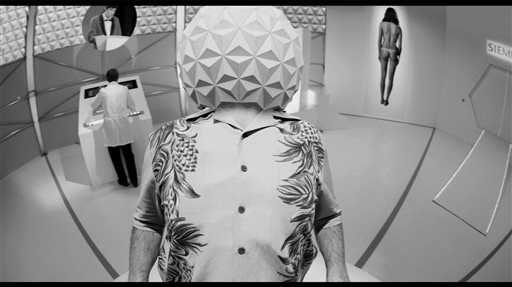
This undated photo released by Mankurt Media, LLC shows Roy Abramsohn as Jim losing his head in a scene from “Escape from Tomorrow,” a feature film by writer/director Randy Moore. As an adult, and a filmmaker, Moore wanted to capture and question the allure of manufactured-fantasy theme parks. The movie is available on video-on-demand and in select theaters Friday, Oct. 11, 2013. AP
LOS ANGELES — As a kid, Randy Moore was haunted by Disney World, where he made an annual trip during summers with his dad. So as an adult, and a filmmaker, Moore wanted to capture and question the allure of such manufactured-fantasy.
The result is “Escape From Tomorrow,” which was shot guerrilla-style at Disneyland and Disney World without permission from the famously proprietary Walt Disney Co.
“I was pretty confident that Disney wasn’t about to go out of their way and give me permission,” Moore said, “so I didn’t ask them for it.”
The writer-director insists there was no other way to tell his story of a frustrated family man who begins losing his grip on reality during a trip to Disney World. So Moore and his crew bought season passes to Disneyland in Anaheim, Calif., and Disney World in Orlando, Fla., and used hand-held digital cameras to shoot scenes and tiny digital audio recorders to capture sound.
They repeatedly rode It’s a Small World and other trademark Disney attractions to film from various perspectives — just like any other theatrical feature.
This undated photo released by Mankurt Media, LLC shows Roy Abramsohn as Jim freaking out during a ride in the amusement park on the last day of his family vacation in a scene from “Escape from Tomorrow”. AP
“Escape From Tomorrow,” available on video-on-demand and in select theaters Friday, first premiered at the Sundance Film Festival earlier this year, where the black and white film quickly built a buzz based on its unauthorized surreptitious shooting style and dark take on Disney.
Representatives from Disney, which has a history of aggressively protecting its image, brands and intellectual property, did not respond to requests for comment for this story. The company also hasn’t spoken to Moore or the film’s distributor.
“We’ve had no contact with Disney at all whatsoever,” Moore said. But if anyone from the Mouse House, as it is known in the industry, did contact him, he wouldn’t be afraid.
“I would ask them if they liked it or what they thought about it,” he said.
The director was afraid, however, during the crew’s secret filming outings at Disneyland and Disney World, but not because they were filming illegally.
“What I was worried about was letting down my cast and crew, who had come on this ride with me,” he said. “As a first-time director, I think the hardest thing is getting everyone to see your vision and believe in it and want to help you to achieve that.”
He never intended to make a guerrilla film, he said: “The style of the film came from the story, and … there was no other way we could make it. I hope to God the next thing I do doesn’t require this same style. It’s traumatizing.”
Yet for Moore, again, it’s not about copyright violations and the wrath of Disney, but rather the time limits inherent in such shooting.
“We believe that the film fell under the fair-use doctrine as a parody of an idyllic day at Disney World. Branding is so much a part of our culture, and it’s everywhere. And (Disney) is everywhere. They’re so ubiquitous, you can’t get away from them even if you tried… To not be able to comment or critique or parody that (ubiquity), I just think it’s morally unacceptable.”